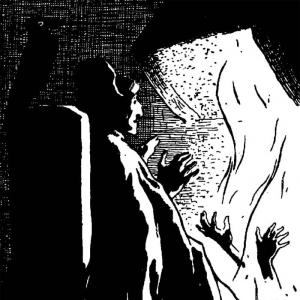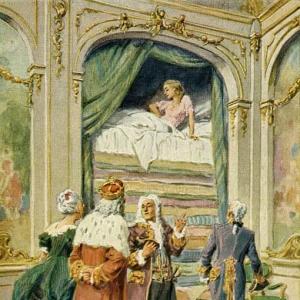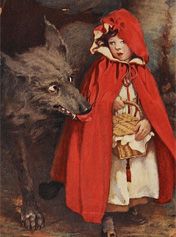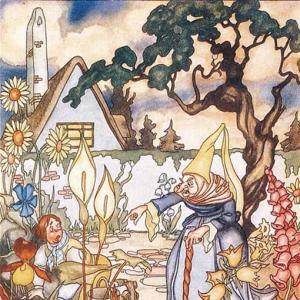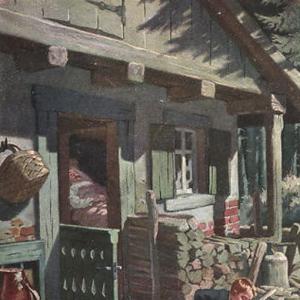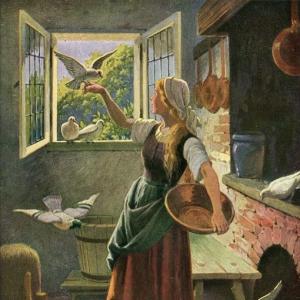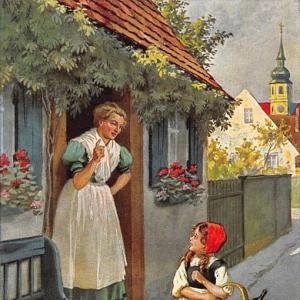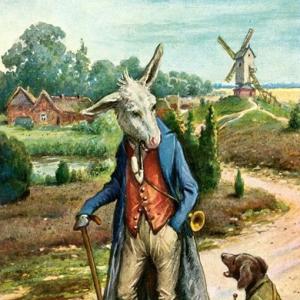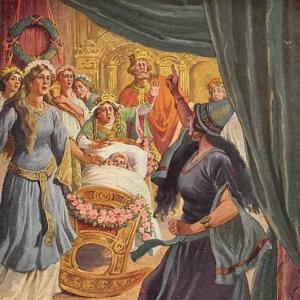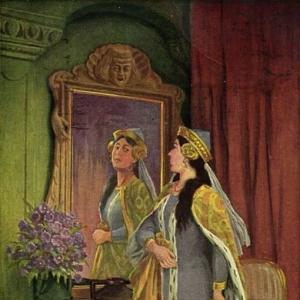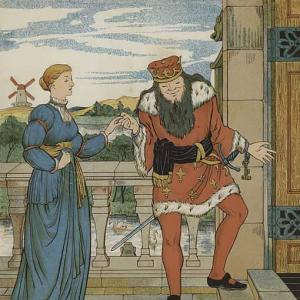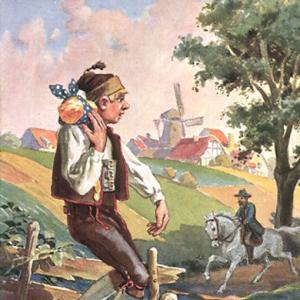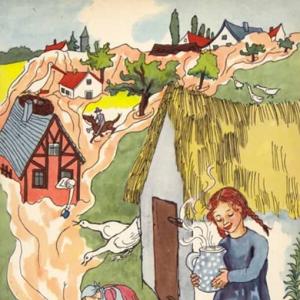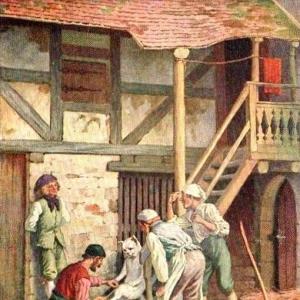Reading time for children: 9 min
In former days every sound still had its meaning and application. When the smith’s hammer resounded, it cried, „Strike away! strike away.“ When the carpenter’s plane grated, it said, „Here goes! here goes.“ If the mill wheel began to clack, it said, „Help, Lord God! help, Lord God!“ And if the miller was a cheat and happened to leave the mill, it spoke high German, and first asked slowly, „Who is there? Who is there?“ and then answered quickly, „The miller! the miller!“ and at last quite in a hurry, „He steals bravely! he steals bravely! three pecks in a bushel.“
At this time the birds also had their own language which every one understood. Now it only sounds like chirping, screeching, and whistling, and to some like music without words. It came into the bird’s mind, however, that they would no longer be without a ruler, and would choose one of themselves to be their King. One alone amongst them, the green plover, was opposed to this. He had lived free, and would die free, and anxiously flying hither and thither, he cried, „Where shall I go? where shall I go?“ He retired into a solitary and unfrequented marsh, and showed himself no more among his fellows.
The birds now wished to discuss the matter, and on a fine May morning they all gathered together from the woods and fields: eagles and chaffinches, owls and crows, larks and sparrows, how can I name them all? Even the cuckoo came, and the hoopoe, his clerk, who is so called because he is always heard a few days before him, and a very small bird which as yet had no name, mingled with the band. The hen, which by some accident had heard nothing of the whole matter, was astonished at the great assemblage. „What, what, what is going to be done?“ she cackled; but the cock calmed his beloved hen, and said, „Only rich people,“ and told her what they had on hand. It was decided, however, that the one who could fly the highest should be King. A tree-frog which was sitting among the bushes, when he heard that, cried a warning, „No, no, no! no!“ because he thought that many tears would be shed because of this; but the crow said, „Caw, caw,“ and that all would pass off peaceably. It was now determined that on this fine morning they should at once begin to ascend, so that hereafter no one should be able to say, „I could easily have flown much higher, but the evening came on, and I could do no more.“ On a given signal, therefore, the whole troop rose up in the air. The dust ascended from the land, and there was tremendous fluttering and whirring and beating of wings, and it looked as if a black cloud was rising up. The little birds were, however, soon left behind. They could go no farther, and fell back to the ground. The larger birds held out longer, but none could equal the eagle, who mounted so high that he could have picked the eyes out of the sun. And when he saw that the others could not get up to him, he thought, „Why shouldst thou fly still higher, thou art the King?“ and began to let himself down again. The birds beneath him at once cried to him. „Thou must be our King, no one has flown so high as thou.“ – „Except me,“ screamed the little fellow without a name, who had crept into the breast-feathers of the eagle. And as he was not at all tired, he rose up and mounted so high that he reached heaven itself. When, however, he had gone as far as this, he folded his wings together, and called down with clear and penetrating voice, „I am King! I am King.“
„Thou, our King?“ cried the birds angrily. „Thou hast compassed it by trick and cunning!“ So they made another condition. He should be King who could go down lowest in the ground. How the goose did flap about with its broad breast when it was once more on the land! How quickly the cock scratched a hole! The duck came off the worst of all, for she leapt into a ditch, but sprained her legs, and waddled away to a neighboring pond, crying, „Cheating, cheating!“ The little bird without a name, however, sought out a mouse- hole, slipped down into it, and cried out of it with his small voice, „I am King! I am King!“
„Thou our King!“ cried the birds still more angrily. „Dost thou think thy cunning shall prevail?“ They determined to keep him a prisoner in the hole and starve him out. The owl was placed as sentinel in front of it, and was not to let the rascal out if she had any value for her life. When evening was come all the birds were feeling very tired after exerting their wings so much, so they went to bed with their wives and children. The owl alone remained standing by the mouse-hole, gazing steadfastly into it with her great eyes. In the meantime she, too, had grown tired and thought to herself, „You might certainly shut one eye, you will still watch with the other, and the little miscreant shall not come out of his hole.“ So she shut one eye, and with the other looked straight at the mouse-hole. The little fellow put his head out and peeped, and wanted to slip away, but the owl came forward immediately, and he drew his head back again. Then the owl opened the one eye again, and shut the other, intending to shut them in turn all through the night.
But when she next shut the one eye, she forgot to open the other, and as soon as both her eyes were shut she fell asleep. The little fellow soon observed that, and slipped away.
From that day forth, the owl has never dared to show herself by daylight, for if she does the other birds chase her and pluck her feathers out. She only flies out by night, but hates and pursues mice because they make such ugly holes. The little bird, too, is very unwilling to let himself be seen, because he is afraid it will cost him his life if he is caught. He steals about in the hedges, and when he is quite safe, he sometimes cries, „I am King,“ and for this reason, the other birds call him in mockery, ‚King of the hedges‘ (Zaunkönig). No one, however, was so happy as the lark at not having to obey the little King. As soon as the sun appears, she ascends high in the air and cries, „Ah, how beautiful that is! beautiful that is! beautiful, beautiful! ah, how beautiful that is!“
 Learn languages. Double-tap on a word.Learn languages in context with Childstories.org and Deepl.com.
Learn languages. Double-tap on a word.Learn languages in context with Childstories.org and Deepl.com.Backgrounds
Interpretations
Adaptions
Summary
Linguistics
„The Willow Wren,“ also known as „The Wren,“ is a fairy tale collected by the Brothers Grimm in their collection „Grimms‘ Fairy Tales“ (originally titled „Kinder- und Hausmärchen“). The Brothers Grimm, Jacob (1785–1863) and Wilhelm (1786–1859) Grimm, were German academics, linguists, and cultural researchers who collected and published folklore during the 19th century. Their work laid the foundation for the modern study of folklore, and their collection of fairy tales is one of the most famous and influential works in the genre.
„The Willow Wren“ is an example of a story with animal characters and anthropomorphized behavior, which is common in many traditional folktales. Such stories often use animals as a means to explore human characteristics, behaviors, and societal issues. These tales often convey moral lessons or cautionary messages through the actions and interactions of their animal characters.
The story is believed to have originated from European folklore, and various versions of the tale have been found across the continent. In some versions, the bird characters represent specific human traits, while in others, they symbolize different social classes or groups. The tale has inspired numerous adaptations, including retellings in different formats, such as books, films, and stage productions.
„The Willow Wren“ offers several interpretations and themes, which include the following:
The danger of power struggles: The story demonstrates how the quest for power and control can lead to conflict and division. The birds‘ insistence on having a king and the ensuing competition highlight the potential problems that can arise from power struggles.
The importance of individuality: The green plover’s decision to live a free life, away from the other birds, can be seen as a celebration of individuality and independence. The story suggests that it is essential to remain true to oneself and not be swayed by the desire for power or societal expectations.
The deceptive nature of appearances: The little bird’s cunning and ability to outsmart the other birds challenge the assumption that size and strength are the only determinants of power and success. The story serves as a reminder that appearances can be deceiving and that resourcefulness and intelligence can be more valuable than physical attributes.
The consequences of arrogance and pride: The other birds‘ initial refusal to accept the little bird as their king, despite his achievements, highlights the dangers of arrogance and pride. Their unwillingness to recognize his accomplishments eventually leads to their own humiliation and defeat.
The value of freedom: The lark’s happiness at not having to obey the little king reflects the value of freedom and autonomy. The story suggests that living without the constraints of hierarchy and power dynamics can lead to a more joyful and fulfilling existence.
Overall, „The Willow Wren“ serves as a cautionary tale that explores the complexities of power, individuality, appearances, and freedom, offering valuable lessons on the importance of remaining true to oneself and the dangers of power struggles.
„The Willow Wren“ has inspired several adaptations and retellings over the years, both in literature and other media. Here are a few examples.
„The King of the Birds“ by James Baldwin: This children’s book retells the story of „The Willow Wren“ with a few variations. In this version, the willow wren is challenged to a competition by a hawk, rather than the other birds. The willow wren ultimately wins the competition by outsmarting the hawk.
„The Willow Wren and the Bear“ by Ethel S. Beswick: This children’s book adds a new character to the story, a bear who challenges the willow wren to a competition. The willow wren wins by using his intelligence and cunning, rather than brute strength.
„The Willow Wren and the Stork“ by the Brothers Grimm: This is a variant of the original story, in which the willow wren and the stork compete to become the king of the birds. The willow wren ultimately wins by using his speed and agility to outmaneuver the stork.
„The Willow Wren and the Sparrow“ by the Brothers Grimm: Another variant of the story, in which the willow wren and the sparrow compete to become the king of the birds. The willow wren wins by tricking the sparrow into flying too high and becoming exhausted.
„The Willow Wren and the Bear“ (animated short film): This 1976 Soviet animated film adapts the story of „The Willow Wren“ with a few variations. In this version, the willow wren is challenged by a bear and must use his intelligence and quick thinking to win the competition.
These are just a few examples of the many adaptations and variations of „The Willow Wren“ that exist. The story continues to inspire new retellings and interpretations to this day.
„The Willow Wren“ is a fairy tale by the Brothers Grimm that tells the story of a time when all sounds had meaning, and birds spoke a language everyone understood. Deciding they need a ruler, the birds gathered to choose a king. The green plover opposed this idea, opting for a free life, and retreated to a marsh away from the other birds.
On a fine May morning, birds of all kinds gathered to discuss the matter. It was decided that the bird who could fly the highest would be king. As the birds ascended, the smaller ones fell behind. The eagle soared the highest, but a small, unnamed bird hiding in the eagle’s feathers went even higher, reaching heaven itself. Proclaiming itself as king, the other birds rejected its claim, accusing it of using trickery.
A new condition was set: the bird who could go down the lowest in the ground would be king. The little bird found a mouse-hole and declared itself king from within. The other birds, still upset, decided to imprison the little bird by having the owl guard the hole. The owl, however, grew tired and fell asleep, allowing the little bird to escape.
Since then, the owl only flies at night, as it is chased and plucked by other birds during the day. The little bird remains elusive, occasionally calling itself king from the safety of hedges, thus earning the mocking title „King of the Hedges.“ The lark, however, is pleased that it doesn’t have to obey the little king and celebrates the sun’s beauty each morning.
The Brothers Grimm fairy tale „The Willow Wren“ presents a rich tapestry for linguistic analysis, using anthropomorphism, symbolic language, and narrative structure to deliver its themes.
Personification and Anthropomorphism: The story is filled with personification, where non-human elements like tools and animals are given human attributes. The smith’s hammer, carpenter’s plane, and mill wheel „speak“ their own language, which becomes an allegory for a time when the natural and human-made world was more closely linked to human culture and society. Similarly, birds are anthropomorphized, possessing not just the ability to converse in human language but also displaying societal structures and emotions.
Characterization through Language: Each bird species is imbued with certain characteristics attributed to their real-world behaviors. The crows, often seen as ominous, simple say „caw“ in response to the situation. The unnamed small bird’s cunning use of the eagle’s feathers and its ultimate cry, „I am King,“ reflect both its cleverness and a certain audacity or hubris.
Symbolic Language and Themes: The tale uses symbolic language to discuss themes of power, cunning, and humility. The unnamed bird’s rise to power and eventual mockery as the „King of the hedges“ symbolize the folly of ambition without strength and the fleeting nature of power obtained through deceit.
Repetition and Rhythm: The repetition of phrases like „Strike away! strike away. “ and „I am King! I am King!“ adds rhythm and reinforces the key actions and declarations, making the story more engaging and memorable. The iterative cries of the lark at the end provide a poetic closure, emphasizing the joy of freedom over the burden of rulership.
Contrast and Irony: The tale contrasts different bird characters and their fates to underline its moral messages. The lark’s happiness in singing freely contrasts with the small bird’s fear and hiding, despite being „king. “ The irony of the owl, a symbol of wisdom, falling asleep on the job functions as a commentary on vigilance and responsibility.
Dialogue and Interaction: Dialogue serves to speed up the narrative and provide insight into the characters’ personalities and motivations. The interactions among the birds, filled with exclamations and questions, bring the reader deeper into the competitive and hierarchical nature of their society.
Cultural and Historical References: The reference to „high German“ and notions of aristocracy and kingship speak to German cultural elements and societal hierarchies contemporary to the Grimms’ time, creating a multi-layered narrative that invites readers to question the legitimacy and morality of leadership and power.
Overall, „The Willow Wren“ uses a variety of linguistic techniques to weave a story that is not only entertaining for children but also offers deeper reflections on human nature and societal structures. Through simple yet powerful language, it continues to resonate, inviting interpretations across generations.
Information for scientific analysis
Fairy tale statistics | Value |
|---|---|
| Number | KHM 171 |
| Aarne-Thompson-Uther-Index | ATU Typ 221 |
| Translations | DE, EN, DA, ES, FR, PT, IT, JA, NL, PL, RU, TR, VI, ZH |
| Readability Index by Björnsson | 26.8 |
| Flesch-Reading-Ease Index | 84.5 |
| Flesch–Kincaid Grade-Level | 5.2 |
| Gunning Fog Index | 8 |
| Coleman–Liau Index | 8.3 |
| SMOG Index | 8.2 |
| Automated Readability Index | 5.4 |
| Character Count | 6.123 |
| Letter Count | 4.691 |
| Sentence Count | 76 |
| Word Count | 1.147 |
| Average Words per Sentence | 15,09 |
| Words with more than 6 letters | 134 |
| Percentage of long words | 11.7% |
| Number of Syllables | 1.451 |
| Average Syllables per Word | 1,27 |
| Words with three Syllables | 56 |
| Percentage Words with three Syllables | 4.9% |

